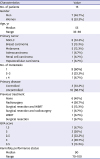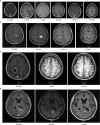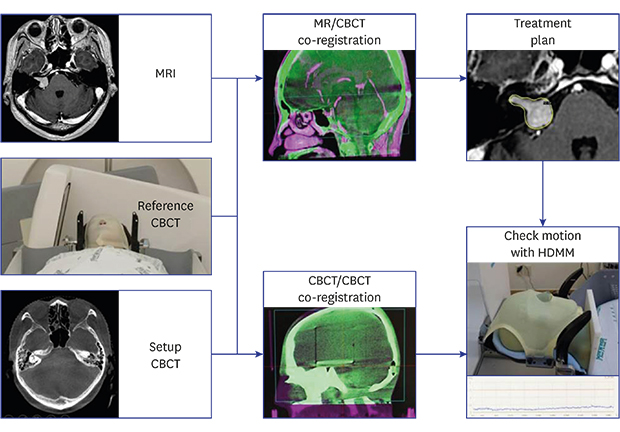1. Kondziolka D, Martin JJ, Flickinger JC, Friedland DM, Brufsky AM, Baar J, et al. Long-term survivors after gamma knife radiosurgery for brain metastases. Cancer. 2005; 104(12):2784–2791.


2. Yamamoto M, Serizawa T, Shuto T, Akabane A, Higuchi Y, Kawagishi J, et al. Stereotactic radiosurgery for patients with multiple brain metastases (JLGK0901): a multi-institutional prospective observational study. Lancet Oncol. 2014; 15(4):387–395.

4. Nguyen JH, Chen CJ, Lee CC, Yen CP, Xu Z, Schlesinger D, et al. Multisession gamma knife radiosurgery: a preliminary experience with a noninvasive, relocatable frame. World Neurosurg. 2014; 82(6):1256–1263.


5. Devriendt D, De Smedt F, Glineur R, Massager N. Five-fraction Gamma Knife radiosurgery using the Extend relocatable system for benign neoplasms close to optic pathways. Pract Radiat Oncol. 2015; 5(3):e119–e125.

6. Dorenlot A, Champoudry J. 25. End-to-end tests of the new Elekta gamma knife ICON. Phys Med. 2016; 32:353.


8. Paek SH, Audu PB, Sperling MR, Cho J, Andrews DW. Reevaluation of surgery for the treatment of brain metastases: review of 208 patients with single or multiple brain metastases treated at one institution with modern neurosurgical techniques. Neurosurgery. 2005; 56(5):1021–1034.

9. Vachhrajani S, Fawaz C, Mathieu D, Ménard C, Cusimano MD, Gentili F, et al. Complications of gamma knife surgery: an early report from 2 Canadian centers. J Neurosurg. 2008; 109:Suppl. 2–7.


10. Kim YJ, Cho KH, Kim JY, Lim YK, Min HS, Lee SH, et al. Single-dose versus fractionated stereotactic radiotherapy for brain metastases. Int J Radiat Oncol Biol Phys. 2011; 81(2):483–489.


11. Aoyama H, Shirato H, Onimaru R, Kagei K, Ikeda J, Ishii N, et al. Hypofractionated stereotactic radiotherapy alone without whole-brain irradiation for patients with solitary and oligo brain metastasis using noninvasive fixation of the skull. Int J Radiat Oncol Biol Phys. 2003; 56(3):793–800.


12. Narayana A, Chang J, Yenice K, Chan K, Lymberis S, Brennan C, et al. Hypofractionated stereotactic radiotherapy using intensity-modulated radiotherapy in patients with one or two brain metastases. Stereotact Funct Neurosurg. 2007; 85(2-3):82–87.


13. Hasegawa T, Kato T, Yamamoto T, Iizuka H, Nishikawa T, Ito H, et al. Multisession gamma knife surgery for large brain metastases. J Neurooncol. 2017; 131(3):517–524.


15. Higuchi Y, Serizawa T, Nagano O, Matsuda S, Ono J, Sato M, et al. Three-Staged Stereotactic Radiotherapy Without Whole Brain Irradiation for Large Metastatic Brain Tumors. Int J Radiat Oncol Biol Phys. 2009; 74(5):1543–1548.


16. Kim JW, Park HR, Lee JM, Kim JW, Chung HT, Kim DG, et al. Fractionated stereotactic gamma knife radiosurgery for large brain metastases: A retrospective, single center study. PLoS One. 2016; 11(9):e0163304.

17. Li W, Bootsma G, Von Schultz O, Carlsson P, Laperriere N, Millar BA, et al. Preliminary evaluation of a novel thermoplastic mask system with intra-fraction motion monitoring for future use with image-guided gamma knife. Cureus. 2016; 8(3):e531.

18. Serizawa T, Ono J, Iichi T, Matsuda S, Sato M, Odaki M, et al. Gamma knife radiosurgery for metastatic brain tumors from lung cancer: a comparison between small cell and non-small cell carcinoma. J Neurosurg. 2002; 97(5):Suppl. 484–488.


19. Simonová G, Liscák R, Novotný J Jr, Novotný J. Solitary brain metastases treated with the Leksell gamma knife: prognostic factors for patients. Radiother Oncol. 2000; 57(2):207–213.

20. Bhatnagar AK, Flickinger JC, Kondziolka D, Lunsford LD. Stereotactic radiosurgery for four or more intracranial metastases. Int J Radiat Oncol Biol Phys. 2006; 64(3):898–903.


21. Lippitz B, Kraepellen T, Hautanen K, Ritzling M, Rähn T, Uffarsson E, et al. Gamma knife radiosurgery for patients with multiple cerebral metastases. Acta Neurochir Suppl (Wien). 2004; 91:79.

22. Shuto T, Fujino H, Inomori S, Nagano H. Repeated gamma knife radiosurgery for multiple metastatic brain tumours. Acta Neurochir (Wien). 2004; 146(9):989–993.


23. Elliott RE, Rush S, Morsi A, Mehta N, Spriet J, Narayana A, et al. Neurological complications and symptom resolution following gamma knife surgery for brain metastases 2 cm or smaller in relation to eloquent cortices. J Neurosurg. 2010; 113:Suppl. 53–64.

24. Casentini L, Fornezza U, Perini Z, Perissinotto E, Colombo F. Multisession stereotactic radiosurgery for large vestibular schwannomas. J Neurosurg. 2015; 122(4):818–824.


25. Kim BS, Im YS, Woo KI, Kim YD, Lee JI. Multisession gamma knife radiosurgery for orbital apex tumors. World Neurosurg. 2015; 84(4):1005–1013.


26. Kim JW, Park HR, Lee JM, Kim JW, Chung HT, Kim DG, et al. Fractionated stereotactic gamma knife radiosurgery for large brain metastases: a retrospective, single center study. PLoS One. 2016; 11(9):e0163304.











 PDF
PDF Citation
Citation Print
Print




 XML Download
XML Download